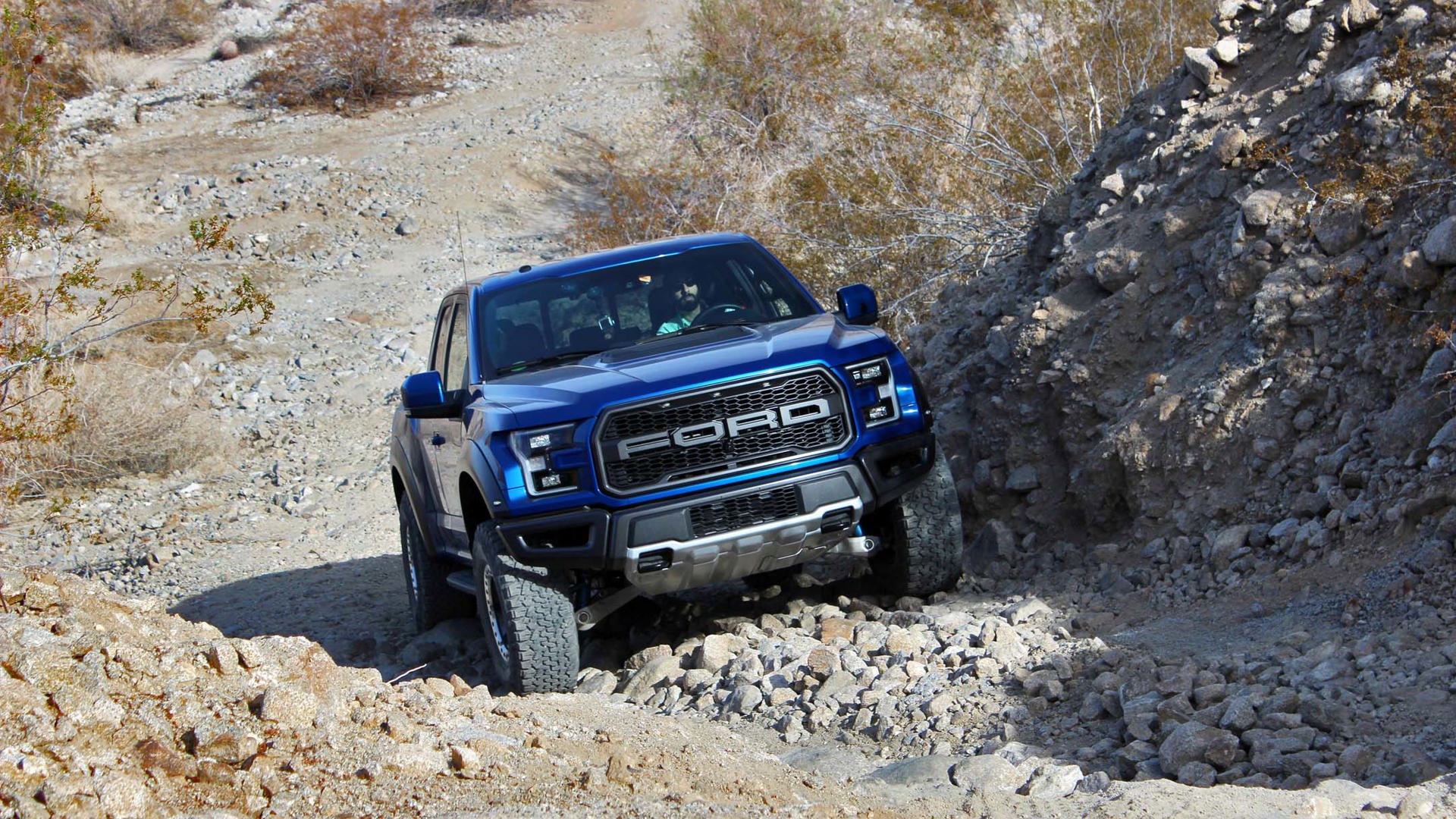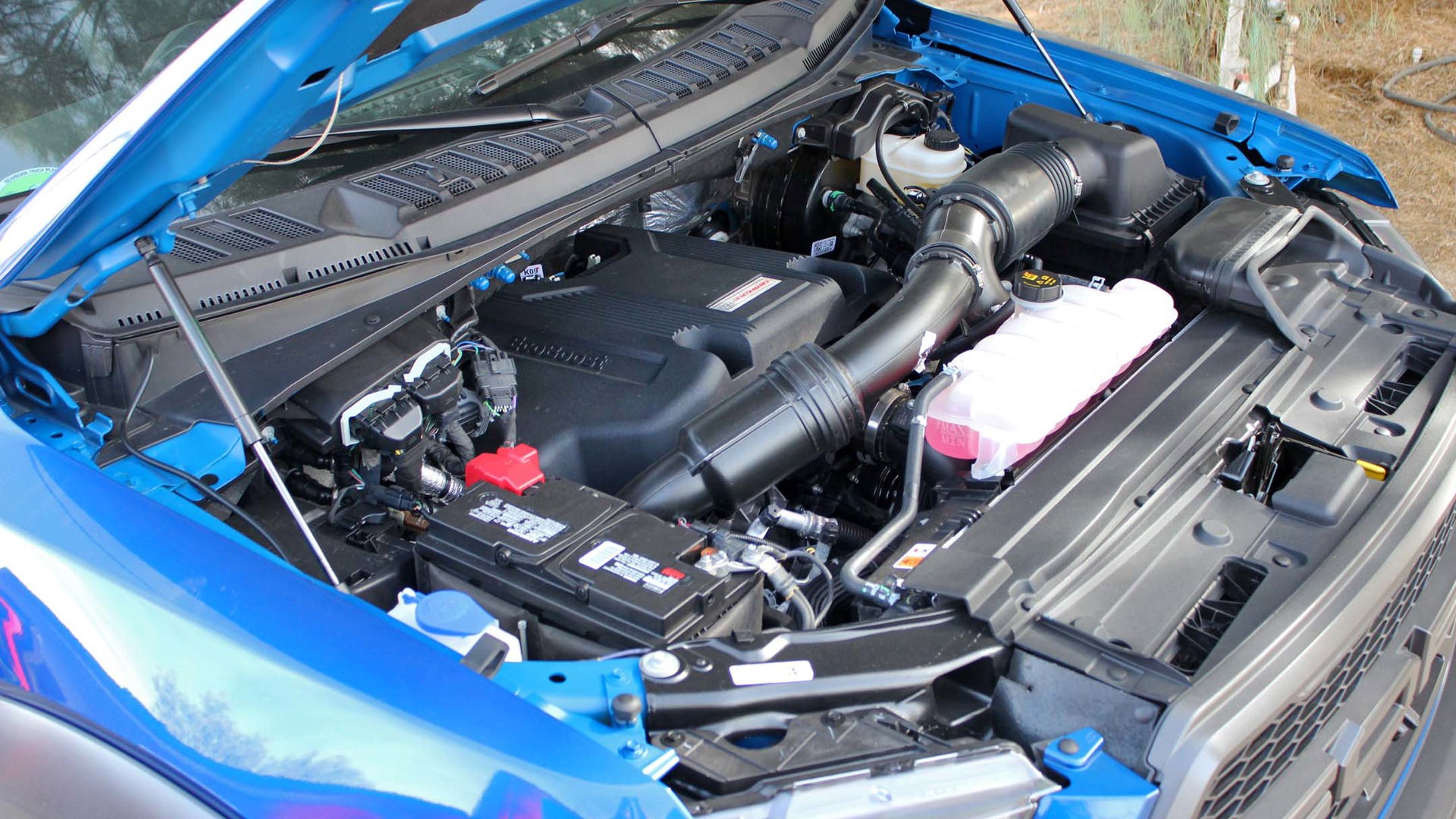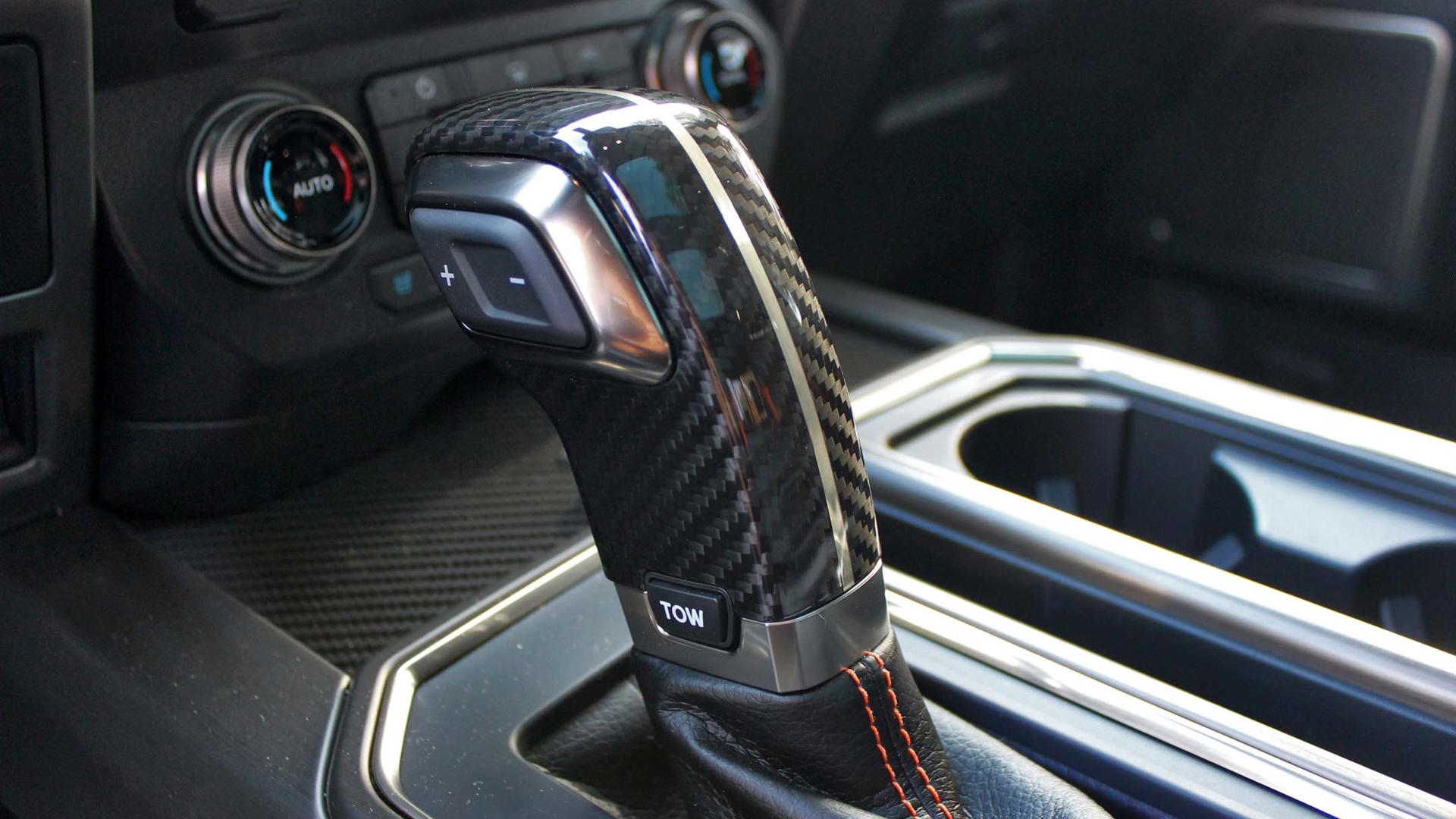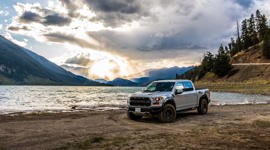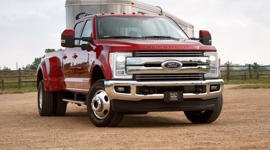Borrego Springs, CA – “Look out! I think they’ve spotted us!” Time to get a grip on the wheel, activate “Baja” mode, and give it hell. It wasn’t going to be long before Immortan Joe and his War Boys in souped-up Beetles and triple-decker Cadillacs were going to be right on top of us. I could see the flags attached to their tails on the horizon. It was going to be very close.
We were being told to give it all we’ve got; this truck can handle it.
At least, that’s what was going through my mind as I delved deeper and deeper into the throttle of what has to be one of the most fun vehicles I’ve driven all year: the all-new 2017 Ford F-150 Raptor. More than that, the setting was just right for all of my Mad Max fantasies: the barren, very dry, very No Country for Old Men of the Anza-Borrego state park in southern California’s San Diego County. It’s here that the US Air Force once tested its bombers – you can still see the shrapnel and the bomb targets – and Ford does some of the off-road testing for the F-150, the Explorer and a number of other products.
And we were being told to give it all we’ve got; this truck can handle it.
Can it ever. First of all, the nuts n’ bolts; yes, for 2017, the Raptor has lost its 6.2L V8 digs and replaced them with a strengthened version of their popular 3.5L EcoBoost V6, albeit one that has been tuned to make 450 hp and 510 lb-ft of torque, both numbers that are up on what was being made by the heavier, thirstier V8 (up to 226 kg have been saved overall, depending on spec). It also gets Ford’s all-new 10-speed automatic transmission (actually, GM uses this too, in much more traditional performance vehicles such as the Camaro), which not only reduces fuel intake, but makes for a much flatter torque curve. Flatter than not just the old Raptor, but much of its competition as well.
That depends, of course, on what you’re counting as the Raptor’s competition. Yes; slightly more performance-oriented versions of standard trucks do exist – the Ram 1500 Rebel and Nissan Titan Pro-4X come to mind – but these are vehicles that Ford says have had to make compromises to get the performance required. Even then, they tend to only really be able to excel in a certain aspect. Ford firmly believes that the Raptor is a better mix of both the performance and capability worlds, and had us test the trucks on the road, on said high-speed desert course and hardcore rock-crawling course to prove it.
The Raptor’s ability to walk the line between these numerous disciplines can actually be pretty easily summed up in two parts: the powerful yet fuel efficient engine, as well as a finely tuned suspension set-up that features all-new Fox dampers that provide 330 mm of travel up front and 355 mm at the rear. Their nine-chamber construction means they can provide a comfortable ride on the tarmac at one moment, and a stable, confidence-inspiring ride over rocks and shale the next.
That, plus BF Goodrich KO2 tires built specifically with the Raptor in mind (you can buy beadlock wheels for the Raptor directly from Ford, but you have to get them installed after the fact as its illegal to sell them that way at retail) was why we were being told to push it so hard through the sand dunes and the loose gravel we were currently on; it takes a lot to get the Raptor unsettled in these types of conditions. Yes; the wide tires and loose surface will sometimes – well, often – cause a yaw movement when you may least expect it, but so good are the tires, the suspension and electronic driver aids – more on these in a moment – that they will have you back on the right track and away from that thicket of spiky cacti in no time.
There are six drivetrain modes you can make use of: Normal, Sport, Weather, Mud/Sand, Baja – yes, Baja; if the Focus RS gets “Drift” and the Mustang GT gets “Burnout” mode, why shouldn’t this latest Ford Performance model get a wildly named drive mode of its own? – and Rock Crawl. Each mode gets presets for steering, powertrain, Advance Trac AWD system, e-differential and transfer case. Baja, for example, ups the traction control intervention but relaxes the steering while Mud/Snow deadens the throttle, but also relaxes the traction control. Of course, a lot of these features – the steering, differential and traction control, which can be fully defeated – can be individually set, but I don’t believe that I’m smarter than Ford’s engineers when it comes to my ideal drive settings, so I didn’t mess with it all that much. Plus, each individual mode is so easy to select – there are buttons on the wheel; no need to sift through menus here – that I found myself switching between them more often.
For example: the high-speed off-road course is a loop that features a common access road – driven twice – as well as a “bowl” (basically a sandy pit you have to power your way through), a selection of narrower passes through deep sand as well as fast sections with “yumps”; small, quick bumps also called “gotchas” which, according to my drive instructor “will catch your wheel and send you flipping” if you don’t approach them the right way. It’s not required to switch between drive modes for all of these, but its highly recommended you do for some (going from Baja on the gravel to Mud/Sand in the bowl, for example) so it’s nice that it can be so easily done.
What’s really impressive about the Raptor, however, is just how quickly it grows on you, how quickly you start to gain faith in just how capable it is. That kind of knowledge leads to some real confidence; I’ll admit that when you consider the truck’s specs, you start out a little tentatively. The first run through the access road is a get-to-know-you run; by the return leg, the Raptor has endeared itself to you and you’re suddenly on a Scandinavian-flicking, tail-out jaunt through the desert, aiming for the tire grooves and letting the strong sidewalls nudge up against the sandbanks to help turn-in and stability. I actually found myself preferring Mud/Snow even on the faster route, thanks to the less-invasive traction control allowing for more freedom of input. Either way; it was “Bye bye, Mr. Joe. “
As nice as it is to be able to so easily switch between drive modes on the fast off-road, we made use of the feature much less on the rock-crawl course. In fact, we pretty much didn’t change anything at all; it was rock-crawl mode, all the time.
Which, it should be said, actually led to my being not necessarily more impressed than I was on the high-speed course, but definitely more surprised about the Raptor’s capabilities. We were on a closed course full of sharp rock and shale that’s used by Ford to test the Raptor, so while in the back of our mind we knew the Raptor could conquer the course, those thoughts tend to fade a little when you’re staring at what looks like a 45 degree climb over loose rock, with portions that look barely wide enough for the ATVs that this seems to be made for.
No matter; the Raptor features some of the best stock wheel articulation and axle freedom – the rear gets a locking axle with leaf springs, the front a Torsen differential with coilovers – in the business. What that means is the fact that your Raptor seems canted at a 45 degree angle doesn’t matter; the truck can take it, and before you know it, you’re back on level ground, as it were. You can watch it all unfold up close and personal, too, thanks to a downward-facing front camera that also lets you see over a berm, when all you see through the windshield is the bright blue California sky. It’s a great feature to have, but the fact it’s mounted flush with the centre console means there are often glare issues, which are especially apparent when the terrain you’re on is all beige-y and bereft of colour. I do love that you can select the camera to face either straight ahead or in a fisheye view, though; in the latter setting, Ford has included guidelines that line up directly with your front tires, so you can easily place the Raptor as you trundle forward. You do have to spec the $7,900 Luxury Package to get the camera, which also adds stuff like power tilt/telescoping wheel, power moonroof, dual-zone climate control, heated steering wheel, and heated and cooled front seats. It’s $7,900 well spent.
Then, as you head back down, a standard-fitment hill-descent system that can be set to keep you at anywhere between 3 and 32 km/h lets you take your feet off the pedals (unless you want to add or scrub speed, which can be done either via the pedals or cruise control system) and focus on finding the best possible line as you head down. Like the fast course, it all becomes so natural, so quickly that you’re piloting the Raptor over immensely varied terrain, relaxed almost to the point where you may as well be navigating the streets of your own neighbourhood.
Speaking of city streets; here, and on the highway, is where the Raptor starts to lose its sheen, just a little. At 6-feet wide thanks to new front fenders, bumpers and track the Raptor is a big girl, and you’re always reminding yourself of that as you pilot it in these conditions. It’s wide enough that amber marker lights are required by law; they’re mounted into the grill, as opposed to on the roof as is normally the case.
We also had the chance to put the Raptor to the test on some tight, windy roads around the San Diego foothills, and while it was fun and just so unique to tackle stuff normally reserved for Miatas and motorbikes in something as hulking as this, I wouldn’t say the Raptor is especially suited for these conditions. Those tires are wide, the steering isn’t especially quick even in Sport mode and that high ride height will having you bobbing and weaving over undulations.
Here’s the thing, though; it doesn’t really matter. It’s also in these types of conditions that you get to experience other stuff that you may not as you crush desert dirt roads, pebbles and twigs pinging off the undercarriage. Stuff like the wonderful exhaust note through the proper dual exhaust that quickly had me forget how much I missed the old V8. Or the surprisingly spacious interior (the Raptor shares both its Super Crew and Super Cab passenger compartments with both the standard F-150 and F-250, though it’s available only with a 5.5-foot bed) with its new, supportive sport seats and smart gauge cluster, whose central display houses everything from your trip info, to the grade you’re on. Add SYNC3 infotainment – one of the best in the game, but a $2,500 option if you don’t have the Luxury Package – and you’ve got a truck that offers a lot more than a skinned Baja truck, though it may not look like it on the outside. The magnesium shift paddles leave little to the imagination, however.
Speaking of exterior looks: not all that much has changed since 2014, when the Raptor was last available; the head- and taillights, of course, are different in keeping with what’s happening in the rest of the F-150 line-up, as the Raptor is, technically, a trim level of that truck. There are also some new colours as well as exterior graphic options, but the latter does come at a $1,350 premium and looks a little cheesy. There are also two tailgate styles: a more laid-back, traditional-looking approach plus one that gets you “RAPTOR” spelled out in giant lettering, kind of like what’s seen on the Ram Rebel. While the graphics are a little much, I like this tailgate treatment as it kind of does well to add to the Tonka-truck appeal. The more you look at it, the more you realize the Raptor is actually a pretty good-looking truck, when it could have been an overly-plasticky, gaudy-looking thing because, you know, it’s got all that craziness underneath. Even Ford is quick to point out their styling goals with the Raptor.
“We like to design our trucks to be purpose built,” said Gordon Plato, the Raptor’s lead designer. “So we’re not designing a monster truck; we’re designing a Baja race truck.” As a result, it has to look purposeful, but not like it’s trying too hard. That doesn’t mean they couldn’t include a few cheeky design flares here and there, however, such as cut-outs in the front splitter to better display the big Fox shocks underneath.
For a truck this big and brawny, it’s little stuff like that which adds to the Raptor experience as a whole. The view dead-on from the front leaves little to the imagination; that aluminum skidplate and those super-wide fenders and tires leave no doubt how performance-based this is. Move to the side, however, and if you’ve skipped the graphics – which I suggest you do – it looks like a pickup, sure, but one that’s got a little more lurking underneath. Plus, choosing a stealthier colour makes it tougher for Immortan and the Boys to spot you.
You may want them to, however, because driving this beast fast in Fury Road conditions is just so durn fun, that you want to do it over, over and over again – Ford had engineers and designers working extra time while developing the Raptor not because they had to, but simply because they wanted to. That’s some pretty high praise, but it’s well-deserved.
Pricing: 2017 Ford F-150 Raptor
Super Cab 4 x 4: $67,899
Super Crew 4 x 4: $69,899









